A poison is a substance that can cause injury, illness or death if it enters the body accidently or deliberately. Some poisons are harmful if you breathe or swallow them, while others are harmful upon direct contact.
- Alcohol
- Drugs
- Cleaning products
- Food (i.e., contaminated water, mishandled food)
- Pesticides
- Plants (i.e., poison ivy)
- Poisonous liquids
- Poisonous gases
Signs and Symptoms:
- Burning around the lips and tongue
- Burning or tearing of eyes
- Change of consciousness
- Chest or abdominal pain
- Diarrhea
- Hallucinations
- Irregular pupil size
- Nausea and vomiting
- Skin color change
- Seizures, headache, dizziness, weaknes
- Troubled breathing
Common Emergency Example(s):
Swallowed Poisons:
These poisons enter the body by swallowing and can include: food, drugs, alcohol, household and cleaning products, pesticides, plants and more. Some substances may not be poisonous if taken in a small quantity.
Inhaled Poison:
A person can also be poisoned by breathing in poison, like certain fumes and gases. Examples include: carbon monoxide (car exhaust), carbon dioxide (from sewers, wells),
chlorine (found in swimming pools), glues and paints.
Absorbed Poison:
These poisons are absorbed through the skin, and include: plants (poison ivy, poison oak and poison sumac), fertilizers, pesticides and more.
Injected Poison :
An injected poison enters the body through bites or stings of insects, spiders, ticks, snakes and / or through medical hypodermic needles.
First Aid Actions / Treatment :
- Assess the scene and check for your safety. Do not approach the person if the scene is unsafe. Keep an eye out for signs of a poison – leaking containers, gases, etc.
- Get a First Aid kit and wear personal protective equipment.
- Activate EMS (Call 9-1-1) and call National Poison Control Center at 1-800-222-1222. Follow dispatcher instructions. Gather the following information and inform poison control of what you learn:
- Type of poison
- Quantity taken / inhaled / touched
- When did it happen?
- Person’s weight; age
- If possible, remove the poison. Remove any contaminated jewelry or clothing and brush off solid substances with gloved hand.
- Rinse contaminated area with water for at least 20 minutes.
- Move the person to a poison-free scene, if possible.
- If CPR is required, be sure to wear a breathing barrier to protect yourself from possible exposure to the poison.

